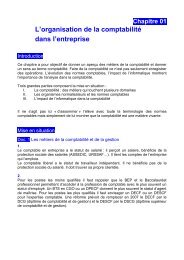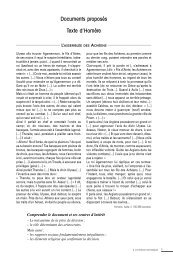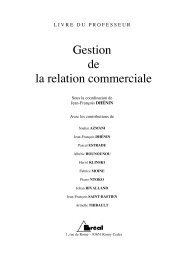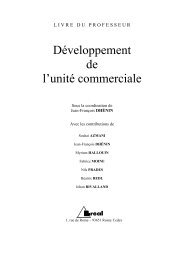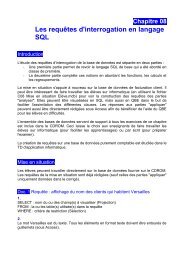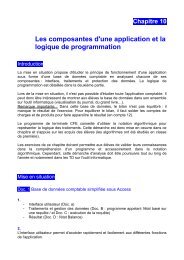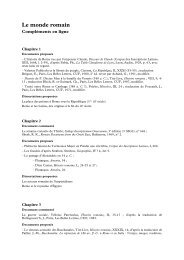correction exercices Précis de Physique-Chimie chapitre 5 à 9
correction exercices Précis de Physique-Chimie chapitre 5 à 9
correction exercices Précis de Physique-Chimie chapitre 5 à 9
You also want an ePaper? Increase the reach of your titles
YUMPU automatically turns print PDFs into web optimized ePapers that Google loves.
La solution pour θ Finale est supérieure à 100°C, cette solution n’étant pas acceptable, il faut supposer que la vapeur<br />
d’eau ne se con<strong>de</strong>nse pas entièrement. L’état final contiendra donc <strong>de</strong> l’eau liqui<strong>de</strong> ainsi que <strong>de</strong> l’eau vapeur. En<br />
appelant m 3 ’ la masse <strong>de</strong> vapeur qui va réellement se con<strong>de</strong>nser, on obtient :<br />
( θ θ ) ( θ θ )<br />
m c − + m c − − m ' L = O<br />
2 eau liqui<strong>de</strong> ébullition l 3 eau vapeur ébullition g 3 V<br />
On peut ainsi en déduire la valeur <strong>de</strong> m 3 ’.<br />
⇒ Pour la 3 ème ligne : la situation est i<strong>de</strong>ntique au cas <strong>de</strong> la secon<strong>de</strong> ligne, il est donc nécessaire <strong>de</strong> supposer que<br />
toute la vapeur d’eau ne se con<strong>de</strong>nse pas.<br />
( θ θ ) ( θ θ ) ( θ θ ) ( θ θ )<br />
m c − + m L + m c − + m c − + m c − − m ' L = O<br />
1 glace fusion g 1 F 1 liqui<strong>de</strong> ébullition fusion 2 liqui<strong>de</strong> ébullition l 3 vapeur ébullition v 3 V<br />
On peut ainsi en déduire la valeur <strong>de</strong> m 3 ’.<br />
⇒ Pour la 4 ème ligne : l’état final est supposé ne contenir que <strong>de</strong> l’eau liqui<strong>de</strong>.<br />
( θ θ ) ( θ θ ) ( θ θ ) ( θ θ ) ' ( θ θ )<br />
m c − + m L + m c − + m c − + m c − − m L + m c − = O<br />
1 glace fusion g 1 F 1 liq Finale fusion 2 liq Finale l 3 vap ébul v 3 V 3 liq Finale ébul<br />
On obtient ainsi le tableau <strong>de</strong> résultats suivant :<br />
État initial<br />
Glace θ g<br />
Eau<br />
liqui<strong>de</strong><br />
θ l<br />
Eau<br />
vapeur<br />
État final<br />
θ v m Glace m Liqui<strong>de</strong> m Vapeur<br />
Température<br />
Finale θ F<br />
m 1 = 50 g - 20°C m 2 = 100 g 100°C m 3 = 0 0 150 g 36,7°C<br />
m 1 = 0 m 2 = 250 g 0 °C m 3 = 100 g 150°C 292 g 58 g 100 °C<br />
m 1 = 100 g -20°C m 2 = 0 m 3 = 100 g 120°C 0 133 g 67 g 100 °C<br />
m 1 = 300 g - 40°C m 2 = 250 g 50 °C m 3 = 100 g 200°C 0 650 g 0 79 °C<br />
Exercices et extraits d’annales<br />
Exercice 6 : Extrait du BTS Travaux Publics 2000<br />
1. Voir §4 <strong>de</strong> ce <strong>chapitre</strong> : Q = 2,51 GJ<br />
p<br />
2.<br />
2.1. Voir §1.8 <strong>de</strong> ce <strong>chapitre</strong> (il faut également tenir compte du ren<strong>de</strong>ment) : Q1 = 1,30 GJ<br />
2.2. Voir §4 <strong>de</strong> ce <strong>chapitre</strong> : ∆θ<br />
1<br />
= 0,52 °C<br />
3.<br />
3.1. Voir §4.4 du <strong>chapitre</strong> 8 :<br />
l’extérieur.<br />
-1<br />
P<br />
2<br />
= − 447 W.m<br />
, le signe négatif provient du fait que l’énergie est cédée à<br />
3.2. Voir §1.6 et §1.7 du <strong>chapitre</strong> 8 :<br />
9<br />
Q<br />
2<br />
= − 3,86.10 J , même remarque que précé<strong>de</strong>mment pour le signe.<br />
3.3. Voir §4 <strong>de</strong> ce <strong>chapitre</strong> : ∆θ<br />
2<br />
= − 1,54 °C<br />
Eléments <strong>de</strong> <strong>correction</strong> <strong>de</strong>s <strong>exercices</strong> du <strong>chapitre</strong> 9 : thermodynamique ■ 67



